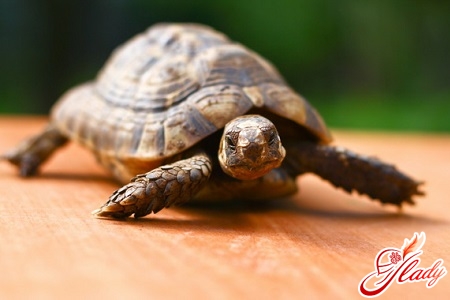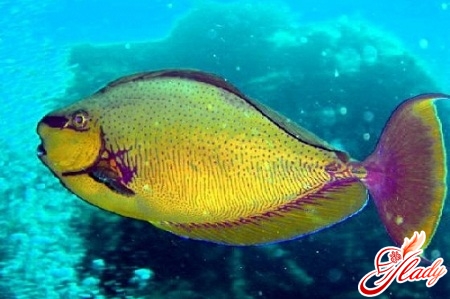 Most pet loversprefers to enjoy the company of warm-blooded representatives of the fauna, covered with wool or feathers. True, there are also many fans of the underwater world and those who want to have an aquarium with fish in their home. But those who choose terrariums and the reptiles, amphibians and insects living in them are rare. But if only a few risk making snakes, spiders and scorpions their pets, then, for example, many get turtles without hesitation. They say that this animal is completely safe, and caring for a turtle at home will not be difficult. But no such luck! Having got such an exotic pet at home, new turtle owners face a lot of problems. After all, a turtle, first of all, needs special conditions of maintenance, it requires specific feeding. In addition, this animal has a peculiarity of hibernating, and it is not insured against all sorts of diseases. So, having decided to get a turtle, you simply must arm yourself with the necessary knowledge.
Most pet loversprefers to enjoy the company of warm-blooded representatives of the fauna, covered with wool or feathers. True, there are also many fans of the underwater world and those who want to have an aquarium with fish in their home. But those who choose terrariums and the reptiles, amphibians and insects living in them are rare. But if only a few risk making snakes, spiders and scorpions their pets, then, for example, many get turtles without hesitation. They say that this animal is completely safe, and caring for a turtle at home will not be difficult. But no such luck! Having got such an exotic pet at home, new turtle owners face a lot of problems. After all, a turtle, first of all, needs special conditions of maintenance, it requires specific feeding. In addition, this animal has a peculiarity of hibernating, and it is not insured against all sorts of diseases. So, having decided to get a turtle, you simply must arm yourself with the necessary knowledge.
Types of domestic turtles
The most common types of pet turtles are:These are red-eared, Central Asian and swamp. These animals differ from other pets by their very long lifespan. In comfortable conditions and with proper care, they can live for about thirty years. Most often, when purchasing these pets in pet stores, we become owners of red-eared turtles. These are water turtles that spend most of their time in the water. However, they need to periodically get out on land, where red-eared turtles rest and walk. This type of turtle is distinguished by the patterned coloring of the shell and special marks - red or yellow spots on the sides of the head. Central Asian turtles lead a terrestrial lifestyle. These are fairly large specimens, reaching a weight of more than one and a half kilograms. Their shell is about twenty centimeters long, and its color varies from a light red shade to a dark olive color. In nature, Central Asian turtles are active only about three months a year. They spend the rest of the time in burrows. Marsh turtles. These familiar, not at all exotic turtles are widespread in Russia. And they usually get into our homes straight from nearby ponds, bypassing shops and markets. Simply, tempted by the opportunity to settle such unusual pets in our home, we make pets out of free animals. They do not have a bright appearance (they have a single-color dark shell), but they can boast excellent health. Some new turtle owners are mistaken, believing that any type of these domestic inhabitants requires standard conditions of maintenance. Yes, of course, in many ways the requirements for keeping turtles are similar, but there are also some differences.
Conditions of detention
Depending on the natural for differentturtles (aquatic or terrestrial) need to be provided with appropriate conditions in captivity. For example, to keep any turtle you will need a terrarium and (or) an aquarium. But... For a red-eared turtle, only a spacious aquarium or aquaterrarium with a volume of at least 100 liters is suitable. In addition to water, there must also be an island of land. It is best to purchase a special island with a sloping slope, a rough surface and a large area of the island itself. The size of the island's surface should be at least a quarter of the total area of the entire aquarium. Here you also need to install a lamp under which your turtle will bask. The aquarium is filled with settled water, which is changed once a month. To keep a land Central Asian turtle, you will need a spacious terrarium with soil and a system for maintaining temperature and humidity. A comfortable temperature for these turtles is 25-28 degrees. The soil layer should be thick enough for your turtle to dig. In addition, a lamp must be installed in the terrarium. In the summer, land turtles can be walked, and if possible, an outdoor enclosure can be equipped for them. The same aquaterrarium as for red-eared turtles is quite suitable for marsh turtles. Only there should be much less water in the aquarium, since in nature these turtles live in shallow water. A lamp must also be installed above the island of land, under which the turtle could warm itself. Marsh turtles eat in the water, and they also defecate here. So the water in the aquarium for the marsh turtle must be changed more often. As for lamps for turtles, these must be incandescent lamps, since fluorescent and ultraviolet lamps do not heat. And turtles have a tendency to hibernate in winter. However, to safely survive this period, the turtle needs special conditions with constant maintenance of the necessary temperature. Therefore, it is better not to let your pets hibernate in winter. To do this, you simply need to raise the temperature in the terrarium or aquaterrarium as soon as you notice that the animal has become less active and has begun to refuse food.
Feeding
Among the turtles there are quite harmless onesherbivores, there are predators, and there are those that will not refuse both plant and animal food. Therefore, when buying a pet turtle, be sure to find out what type of food your pet needs. For example, red-eared turtles need protein food. Therefore, they are fed with bloodworms, minced meat or special granulated feed. Note that only meat should not be given to turtles, otherwise they will get rickets. Therefore, include fish (boiled) in their diet and supplement the menu with green salad, young cabbage leaves and pond algae. Feeding red-eared turtles under two years of age is carried out daily, and older individuals are given food two or three times a week. Land Central Asian turtles are fed coarse-fibered plant food. Non-starchy root vegetables (carrots, beets), lettuce, white cabbage, tough grass, dandelion leaves, zucchini, and apples are excellent for their diet. All these fruits and vegetables (except lettuce and cabbage) must be chopped on a grater, then placed in a feeder, and after an hour and a half to two hours, the remains of the food must be removed from the terrarium. Marsh turtles are predators, although some of them are omnivorous. Therefore, their diet should be based on protein food. It is best to feed them earthworms, large bloodworms, pond snails, fish, and meat. But if adult marsh turtles can be given whole fish or small pieces of meat, then for feeding young turtles this food must be chopped, cutting into small narrow strips similar to worms.
Hygiene
Unlike the same cats, dogs or evenBirds turtles do not need constant and careful care. The main care for these pets comes down to timely and proper feeding, as well as cleaning the aquarium or terrarium. However, for example, land Central Asian turtles also need to periodically trim their claws and beak. However, this is only necessary when the bedding in the terrarium is not hard enough for the claws to wear down naturally. For this procedure, the turtle's paw is examined against the light. If the tips of the claws are transparent, they can be trimmed - this is the excess overgrown part without blood vessels. Claws are trimmed with nippers. The edges of the beak are also trimmed, which are then leveled with a nail file. In addition, land turtles need to be bathed periodically. This procedure is necessary not only for hygienic purposes, but also to maintain the water balance of the turtle's body, since they drink through the skin. Once a week, the turtle is placed in a bath for twenty to thirty minutes. The water should be soft, without added detergents and at a temperature of about 30 degrees. You can add chamomile tea to the water, and during the molting period, baking soda. And do not forget that this is a land turtle, so its head should remain above the water during bathing. If necessary, only the claws of red-eared turtles are trimmed, and the beak is not touched. Neither the beak nor the claws of bog turtles are shortened. So all hygiene procedures for these turtles are reduced to changing the water and cleaning the aquarium.
Contraindications
In caring for turtles, as well as in the rules for theirmaintenance, there are some kind of taboos. Violation of these prohibitions can lead to very sad consequences, since it is very difficult to treat an injured or sick turtle. And so that the animal kept at home is not exposed to potential danger, remember what you cannot do.
In short, turtles should not be allowed in the homeeverything that can have a negative impact on their health or be dangerous to their lives. How could it be otherwise? After all, we are responsible for those we have tamed. We recommend reading:









